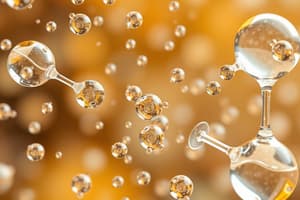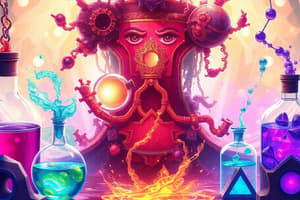Podcast
Questions and Answers
What is general chemistry primarily the study of?
What is general chemistry primarily the study of?
- The study of nuclear reactions.
- The application of chemical principles to biological systems.
- The study of carbon-containing compounds exclusively.
- Matter and its properties, and how matter changes. (correct)
A liquid has a fixed shape but not a fixed volume.
A liquid has a fixed shape but not a fixed volume.
False (B)
What is the smallest unit of an element that retains its chemical properties?
What is the smallest unit of an element that retains its chemical properties?
atom
A substance composed of two or more elements chemically combined in fixed proportions is called a ______.
A substance composed of two or more elements chemically combined in fixed proportions is called a ______.
Match the following terms with their correct descriptions:
Match the following terms with their correct descriptions:
In a chemical reaction, what are the starting materials called?
In a chemical reaction, what are the starting materials called?
Balancing chemical equations violates the law of conservation of mass.
Balancing chemical equations violates the law of conservation of mass.
What is the SI unit for the amount of a substance?
What is the SI unit for the amount of a substance?
What is the number of entities in one mole of a substance known as?
What is the number of entities in one mole of a substance known as?
The limiting reactant is present in a greater amount than necessary to react with all of the other reactants.
The limiting reactant is present in a greater amount than necessary to react with all of the other reactants.
What is the term for a homogeneous mixture of two or more substances?
What is the term for a homogeneous mixture of two or more substances?
A substance that donates protons (H+) in aqueous solutions is called an ______.
A substance that donates protons (H+) in aqueous solutions is called an ______.
Match the following terms with their definitions:
Match the following terms with their definitions:
Which of the following describes an endothermic reaction?
Which of the following describes an endothermic reaction?
According to the second law of thermodynamics, the entropy of the universe decreases in a spontaneous process.
According to the second law of thermodynamics, the entropy of the universe decreases in a spontaneous process.
What is the name of the constant that relates pressure, volume, temperature, and number of moles of a gas?
What is the name of the constant that relates pressure, volume, temperature, and number of moles of a gas?
The process of reducing the concentration of a solution by adding more solvent is called ______.
The process of reducing the concentration of a solution by adding more solvent is called ______.
Which of these is the definition of molar mass?
Which of these is the definition of molar mass?
Flashcards
What is matter?
What is matter?
Anything with mass that occupies space.
Common states of matter
Common states of matter
Solid, liquid, and gas.
What is an element?
What is an element?
Cannot be broken down into simpler substances chemically.
What is a compound?
What is a compound?
Signup and view all the flashcards
What is an atom?
What is an atom?
Signup and view all the flashcards
What is a molecule?
What is a molecule?
Signup and view all the flashcards
What are ions?
What are ions?
Signup and view all the flashcards
What is a chemical reaction?
What is a chemical reaction?
Signup and view all the flashcards
Avogadro's Number
Avogadro's Number
Signup and view all the flashcards
Limiting Reactant
Limiting Reactant
Signup and view all the flashcards
Solution
Solution
Signup and view all the flashcards
Concentration
Concentration
Signup and view all the flashcards
Acids
Acids
Signup and view all the flashcards
pH Scale
pH Scale
Signup and view all the flashcards
Pressure (P)
Pressure (P)
Signup and view all the flashcards
Enthalpy (H)
Enthalpy (H)
Signup and view all the flashcards
Exothermic Reactions
Exothermic Reactions
Signup and view all the flashcards
Chemical Equilibrium
Chemical Equilibrium
Signup and view all the flashcards
Study Notes
- General chemistry involves studying matter, its properties, and its changes.
- It provides the groundwork needed for other chemistry areas.
Matter
- Matter possesses mass and occupies space.
- The three states of matter are solid, liquid, and gas.
- Solids maintain a consistent shape and volume.
- Liquids maintain a consistent volume but adapt to the shape of their container.
- Gases lack a definite shape or volume and are compressible.
- Plasma is sometimes referred to as the fourth state of matter.
Elements and Compounds
- Elements are substances that cannot be simplified into other substances through chemical processes.
- Elements form the basic components of matter.
- Compounds consist of two or more elements chemically joined in specific ratios.
- Compounds can be broken down into simpler substances or elements through chemical reactions.
- Mixtures are combinations of multiple substances that are physically mixed.
- Mixtures may either be homogenous or heterogeneous.
Atoms and Molecules
- Atoms are the smallest unit of an element with the same chemical attributes.
- Atoms comprise protons, neutrons, and electrons.
- Molecules are two or more atoms chemically bonded.
- Molecules can consist of a single element or multiple.
- Ions are atoms or molecules that have gained or lost electrons, which creates a net electrical charge.
- Cations are ions that carry a positive charge.
- Anions are ions that carry a negative charge.
Chemical Reactions and Equations
- Chemical reactions involve the rearrangement of atoms and molecules.
- Chemical equations use formulas and symbols to represent chemical reactions.
- Reactants are the initial materials combined in a chemical reaction.
- Products are the substances that result from a chemical reaction.
- Chemical equations should be balanced according to the law of conservation of mass.
- Balancing ensures the type and number of atoms are equal on both reaction sides.
Stoichiometry
- Stoichiometry involves the quantitative relationships between reactants and products in chemical reactions.
- The mole is the SI unit defining the amount of a substance.
- Avogadro's number is 6.022 x 10^23, representing the entities in one mole of a substance.
- Molar mass is the mass of one mole of a substance, expressed in grams per mole (g/mol).
- Stoichiometric calculations employ mole ratios from balanced equations to find reactant and product amounts.
- The limiting reactant is the reactant depleted first in a chemical reaction.
- The excess reactant is the reactant present beyond what is needed.
- Theoretical yield is the maximum product amount that can be created.
- Actual yield is the product amount obtained from a chemical reaction.
- Percent yield is actual yield related to theoretical yield.
Solutions
- Solutions are homogeneous mixtures.
- A solute dissolves into a solvent.
- A solvent facilitates the dissolution.
- Concentration measures the amount of solute in solvent or solution.
- Molarity, expressed as M, defines the number of solute moles per liter of solution.
- Dilution is the process of reducing a solution's concentration by adding a solvent.
Acids and Bases
- Acids release protons in solutions.
- Bases accept protons, or release hydroxide ions, when combined with water.
- The pH scale is from 0-14 and measures acidity or basicity.
- On the pH scale, 7 is neutral, values lower than 7 are acidic, and values higher than 7 are alkaline.
- Strong acids and bases fully dissociate in water, whereas weak acids and bases only partly dissociate.
- Acid-base neutralization reactions involve the reaction of an acid with a base to create salt and water.
Gases
- Gases are a state of matter without a fixed shape or volume and can be compressed.
- Gas laws dictate gas behavior and include: Boyle's law, Charles's law and the ideal gas law (PV = nRT).
- Pressure (P) is the force per area unit.
- Volume (V) is the space a gas occupies.
- Temperature (T) reflects the gas molecules' average kinetic energy.
- The ideal gas constant (R) links pressure, volume, temperature, and gas moles.
Thermodynamics
- Thermodynamics studies energy and its changes
- Energy can do work or transfer heat
- The first law of thermodynamics states that energy is always conserved
- Enthalpy (H) measures a system's heat at constant pressure
- Exothermic reactions emit heat and have a negative ΔH
- Endothermic reactions require heat and have a positive ΔH
- Entropy (S) measures a system's disorder
- The second law of thermodynamics the universe's entropy always rises during spontaneous processes
- Gibbs free energy (G) uses enthalpy and entropy to indicate a process's spontaneity
- A negative ΔG signifies a spontaneous process, a positive ΔG indicates a non-spontaneous process, and a ΔG of zero indicates a system at equilibrium.
Chemical Kinetics
- Chemical kinetics studies reaction rates.
- Reaction rates are the concentration change of reactants or products over time.
- Reaction rates depend on temperature, concentration, surface area, and catalysts.
- Catalysts accelerate reactions by reducing activation energy.
- Reaction mechanisms detail elementary reactions in a chemical reaction.
Equilibrium
- Chemical equilibrium occurs when forward and reverse reaction rates equalize.
- At equilibrium, reactant and product concentrations show no net change.
- The equilibrium constant (K) quantitatively shows reactant and product amounts at equilibrium.
- Le Chatelier's principle indicates a system at equilibrium will counteract applied changes in conditions.
- Factors such as temperature, pressure, or reactant/product concentration can cause changes to the reaction in equilibrium.
Redox Reactions
- Redox reactions transfer electrons.
- Oxidation involves losing electrons.
- Reduction involves gaining electrons.
- Oxidizing agents gain and are reduced.
- Reducing agents lose and are oxidized.
- Balancing redox reactions commonly uses the half-reaction method.
Studying That Suits You
Use AI to generate personalized quizzes and flashcards to suit your learning preferences.
Description
Explore general chemistry, the study of matter and its properties. Learn about the three common states of matter: solid, liquid, and gas. Discover the differences between elements and compounds, and how they form the building blocks of matter.




